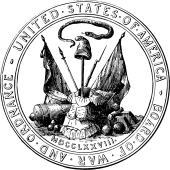|
Seal and emblem of the United States Department of the Army    The Department of the Army Seal and the Department of the Army Emblem are, respectively, the official seal and emblem of the United States Department of the Army (formerly, of the War Department).[2] The "War Office Seal" was created in 1778 and the Emblem was developed out of the seal and approved in 1947. HistoryThe Army Seal was used originally during the American Revolution to authenticate documents. It displayed the designation "War Office", which was synonymous with Headquarters of the Army, and the Roman date MDCCLXXVIII (1778) the first time it was used. It remained unchanged until 1947, when the War Office banner was replaced with "Department of the Army" and the date was changed to 1775, the year in which the Army was established. The seal embodies the Army's ideals of loyalty, vigilance, perseverance, truth, courage, zeal, fortitude, remembrance, determination, constancy, achievement, dignity, and honor. The changes were legislated by the National Security Act of 1947, and authorized by Section 3011, Title 10, United States Code. Prior to the establishment of the "Department of the Army Emblem", there was no official display item to identify the Army. The Seal had traditionally been used to authenticate documents only and was not authorized for public display. In recognizing the need to provide a display item, the Secretary of the Army approved the emblem design as the official emblem to represent the Army on January 29, 1974. DescriptionThe Army Institute of Heraldry describes the War Office Seal as follows:
Although the U.S. Department of the Army's emblem is derived from the Seal of the U.S. Department of the Army, it differs from the seal in several respects:
SymbolismThe central element of the seal and emblem, the Roman cuirass, is a symbol of strength and defense. The sword, esponton (a type of half-pike formerly used by subordinate officers), musket, bayonet, cannon, cannonballs, mortar, and mortar bombs are representative of Army implements. The drum and drumsticks are symbols of public notification of the Army's purpose and intent to serve the Nation and its people. The Phrygian cap (often called the "Cap of Liberty") supported on the point of an unsheathed sword and the motto "This We'll Defend" on a scroll held by the rattlesnake is a symbol depicted on some American colonial flags and signifies the Army's constant readiness to defend and preserve the United States. The symbolism for the elements of the emblem is the same as for the seal with the deviations and additions noted under "Description" above: The colors of the design elements are those traditionally associated with the ideals of the United States and of the U.S. Army. The flags are depicted in their approved colors. Blue is symbolic of loyalty, vigilance, perseverance, and truth. Red denotes courage, zeal, and fortitude. White alludes to deeds worthy of remembrance. Black is indicative of determination and constancy. Gold represents achievement, dignity, and honor. Current usageThis "War Office Seal" continues to be used to this day when legal certification is necessary to authenticate as "official" documents and records of the Department of the Army. Reproduction of the emblem is authorized in publications and other printed matter of an official or quasi-official nature in U.S. Army approved films and in official U.S. Army motion pictures or television programs. The design may not be modified in any manner. It may be reproduced in its proper colors, through the use of a one-color line process, or as a line drawing. The use of the emblem for any other purposes, including its incorporation in other items for commercial sale, will be only as authorized by the Institute of Heraldry. References
|